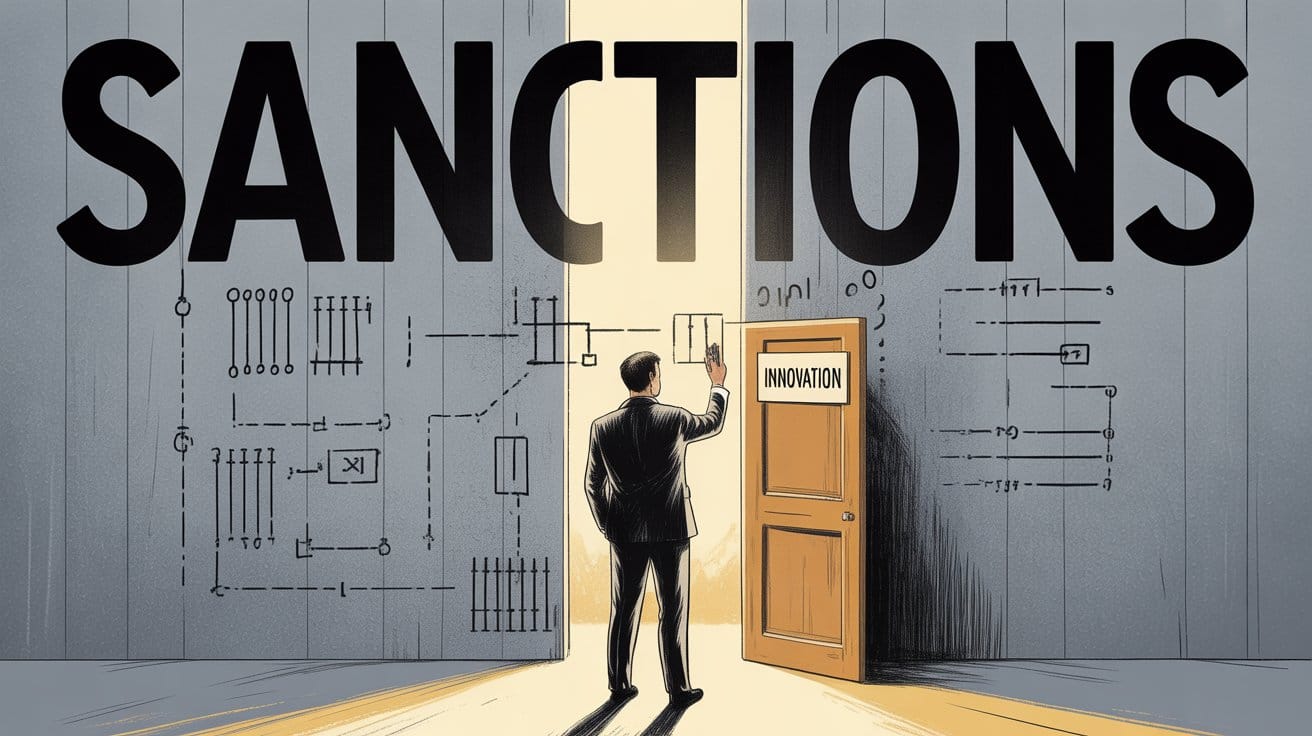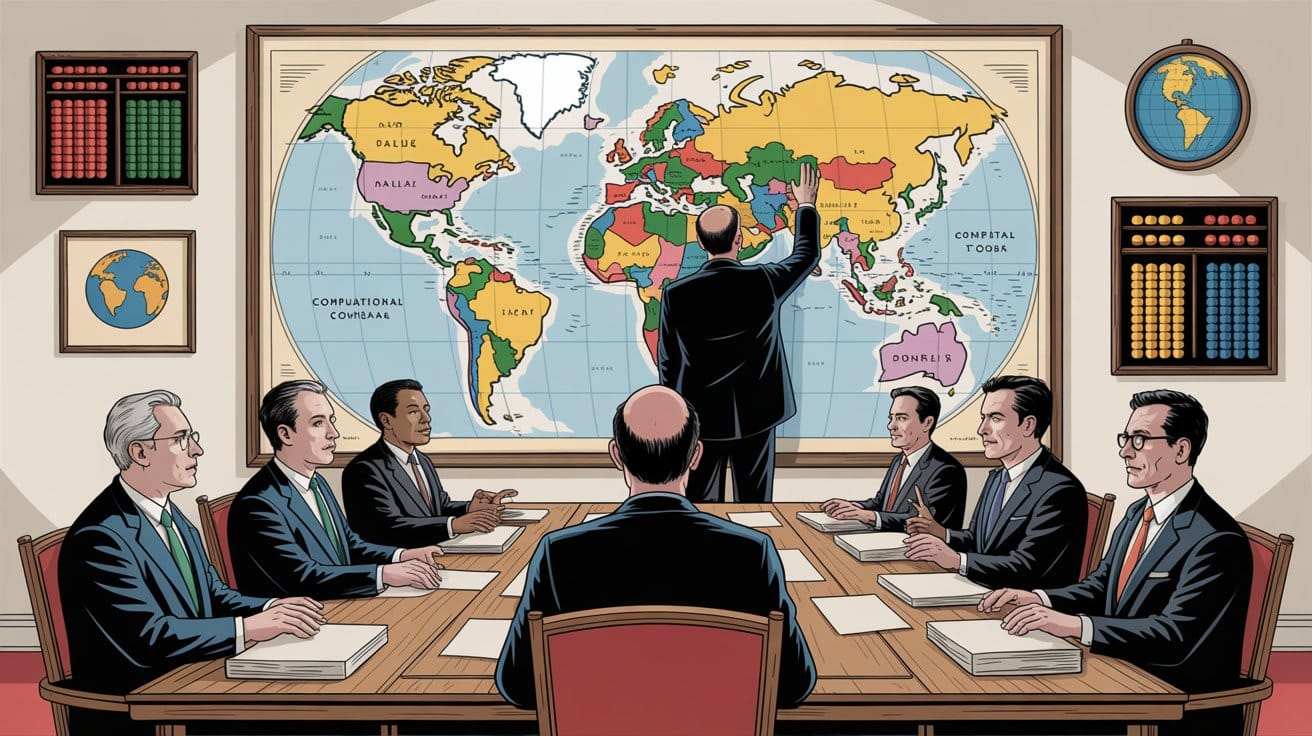

"Necessity is not the mother of invention. Knowledge and experiment are its parents. It sometimes happens that successful search is made for unknown materials to fill well-recognized and predetermined requirements. It more often happens that the acquirement of knowledge of the previously unknown properties of a material suggests its trial for some new use."
— According to Willis R. Whitney, founder of GE Research Laboratory, back when "disruption" meant something was broken, not profitable.


How China's Quest for Energy Efficiency Sparked Computing's Next Paradigm
Binary, meet your successor. It's not personal, it's just ternary
When I first heard about Huawei's ternary chip announcement, I thought it was fake news. Another desperate PR stunt from a company backed into a corner. But then I started digging into the technical papers, and the math actually works. While Intel and TSMC were burning billions chasing 2-nanometer processes that might never be profitable, Huawei apparently decided the whole game was rigged and just changed the rules. Three states instead of two. Simple as that, except it's not simple at all, and that's what makes it so damn clever.
What happened here tells us something important about how innovation actually works—though I'm not sure we're going to like the lesson. When you try to stop technological progress, you often end up redirecting it into channels you never saw coming. It's enough to make you question whether our entire framework for understanding competition and control means anything in a world fragmenting faster than we can track it.
The Technical Revolution

Binary's Eight-Decade Reign
To understand the magnitude of this shift: we've been driving on two-lane roads for eight decades. Every piece of information crawls along as ones and zeros, thanks to Claude Shannon's brilliant 1948 insight that turned communication into mathematics. It worked. Boy, did it work.
Binary was never meant to be the final answer—just the best we could do at the time.
Back in 1958, Soviet researchers at Moscow State University actually figured this out. They built something called Setun—the world's first ternary computer. Where binary only knew on and off, this thing had three states. The math behind it was beautiful: you could get 27 different combinations with three "trits" compared to binary's measly eight combinations with three bits.
The problem? Their hardware couldn't handle it. Temperature changes would scramble the signals. The thing was unreliable as a Soviet elevator. Great idea, wrong decade.
Fast-forward to 2025, and Huawei just made the Soviet dream real. They've cracked the code on that third state—a computational "maybe" sitting between "yes" and "no."
The numbers are wild: 40% fewer transistors, uses 60% less power, runs 20% faster.
That's not optimization. That's revolution.
The Physics of Three States
The technical specs are genuinely impressive, though I'll admit some of this stuff is still over my head. Huawei's quantum state isolated gate technology can apparently distinguish between three voltage levels with nanometer precision—0V for '0', 1.65V for '+1', and 3.3V for '-1'.
Carbon nanotube field-effect transistors make it possible—these aren't your grandfather's transistors. Multi-layered nanoscale insulation keeps everything stable. The error rate? Less than 0.00001%. They solved the reliability nightmare that killed the Soviet attempt.
The math gets beautiful here. Binary needs eight transistors to represent the number 128. Ternary does it with five. That's not just efficiency—it's architectural jujitsu.
When you jump from base-2 to base-3, the gains aren't linear. They compound. In certain computational domains, we're looking at exponential improvements.
But here's what really gets me excited: ternary computing plays nice with quantum mechanics. The three-state structure mirrors quantum superposition in ways that binary never could. We might be looking at a bridge between classical and quantum computing that sidesteps the error correction headaches plaguing current quantum systems.
Nobody saw that coming.
Innovation Under Pressure

Sanctions as Catalyst
Here's what really gets me about this whole situation. Huawei's breakthrough didn't happen despite the sanctions. It happened because of them. And honestly? That irony is the kind of thing that makes you lie awake wondering what else we've got completely backwards.
When U.S. export controls slammed the door on advanced semiconductor tools, they didn't just lock Huawei out—they unleashed them from binary constraints.
The company couldn't tinker around the edges anymore. No more incremental gains. No more squeezing marginal improvements from existing architectures. They were forced into the wilderness of first principles thinking.
Can't optimize binary? Screw binary. Throw out the whole damn paradigm.
It's the innovation equivalent of burning your boats on the beach. When retreat becomes impossible, you discover possibilities that comfort never reveals. While Western chipmakers were grinding through increasingly expensive manufacturing node improvements—chasing 3nm, 2nm, whatever-comes-next nanometer—Huawei was asking a completely different question:
What if the fundamental architecture is wrong?
That's not disruption. That's demolition.
The Historical Pattern
I've seen this pattern before, and it's always the same beautiful disaster. Darwin? Seasick for five years on a floating prison, forced to stare at finches until the obvious became revolutionary. Einstein? A glorified patent office clerk who couldn't get a real academic job, so he sat around thinking heretical thoughts about time and space while rubber-stamping other people's inventions. Mendel? Stuck counting pea plants in his garden because the scientific establishment thought monks should stick to prayers, not patterns.
The establishment doesn't innovate. It administers. Innovation comes from people with nothing left to lose and nowhere else to go.
Constraint breeds breakthrough. Always has.
The numbers tell the story. NVIDIA lost over $11 billion in China revenue when export controls tightened. You'd expect Chinese AI development to crater, right?
Wrong. It accelerated.
Chinese teams could no longer import their computational building blocks. They had to innovate or die. Meanwhile, American firms—comfortable, dominant, profitable— had zero incentive to reinvent the wheel.
Guess who started thinking outside the box?
Market Disruption and Power Shifts

Computational Democratization
But here's where it gets really interesting. If Huawei's numbers hold up—and that's still an if—we're not just talking about faster computers.
We're talking about democratization—not the feel-good kind, but the dangerous kind. When computational barriers collapse, the gatekeepers lose their gates. Suddenly, a graduate student in Bangladesh can train AI models that required Google-scale resources last year. A startup in Lagos can run simulations that only Boeing could afford before. The computational aristocracy just got a very rude awakening.
Take autonomous driving. The experimental data shows ternary accelerators cut computation costs by 67%. For automakers running trillions of operations daily, that's hundreds of millions in annual savings.
More importantly? It brings advanced AI within reach of smaller companies, research institutions, developing nations—anyone who couldn't afford to play in the computational big leagues before.
The automotive example is just the beginning. When fundamental computational costs drop by orders of magnitude, everything changes. Edge computing becomes viable for mom-and-pop operations. Real-time language translation gets cheap enough for local businesses. Personalized medicine stops being the exclusive domain of major research hospitals.
Climate modeling—one of the most computationally expensive scientific endeavors on the planet—suddenly becomes accessible to universities that couldn't dream of affording it before.
That's not just efficiency. That's power redistribution.
Building the Ecosystem
Of course, brilliant technology means nothing without an ecosystem. The Soviet Setun was a marvel of engineering that died in isolation—no software, no tools, no path to market.
Huawei learned that lesson.
They didn't just build a chip. They built a kingdom. Harmony OS with native ternary support. The Ascend AI platform optimized for three-state logic. A supply chain spanning over 1,000 domestic suppliers.
This isn't just a response to technological isolation—it's the most sophisticated pivot in modern tech history. Instead of creating drop-in replacements for Western components, they've built an entirely parallel universe. One that might actually be better than what it's replacing.
The Format War Ahead
If ternary computing actually catches on—and that's still a big if—we might be looking at something like Betamax versus VHS, except with the entire digital world at stake.
Remember that battle? Sony's Betamax was technically superior in almost every way—better picture quality, more reliable mechanics, smaller cassettes. But VHS won anyway. Why? Longer recording times, cheaper licensing, and crucially, the porn industry backed it. Technical superiority meant nothing when network effects and ecosystem adoption tilted the other direction.
The winner wasn't determined by engineering excellence. It was determined by who built the bigger tent.
Now imagine that same format war, but instead of home entertainment, it's the foundational logic of all computing. Your ternary smartphone trying to talk to binary cloud servers. Financial markets where trading algorithms literally can't communicate across architectural lines. Medical devices that speak different computational languages in the same hospital.
Unlike video formats, you can't just build adapters. The mathematical foundations are different. It's not conversion—it's transformation, and transformation always loses something in the process.
We could end up with two completely parallel digital civilizations. One running on eighty years of binary optimization and network effects. Another potentially more efficient but starting from zero ecosystem-wise. The global internet fragmenting along computational lines that make today's streaming service wars look like a playground dispute.
The scary part? Just like with Betamax, technical superiority might not matter. Ecosystem adoption will. And ecosystems are built on momentum, not mathematics.
Strategic Implications

Rethinking Technological Leadership
For decades, Western semiconductor leaders focused on one thing: making things smaller. Smaller transistors, more advanced lithography, higher densities. The assumption was always that computational progress meant refining what we already had.
Ternary computing suggests that assumption was expensive.
While Intel and AMD chase ever-smaller manufacturing nodes with ever-higher costs, Huawei potentially leapfrogged the entire game. Information density through architectural innovation, not manufacturing precision. Same destination, completely different route.
This raises uncomfortable questions about technological leadership. Does dominance eventually become a trap? When you're winning with the current playbook, why risk rewriting it?
The history of disruption suggests that breakthrough innovations almost always come from outsiders. People who aren't invested in the existing success story, who can afford to think differently because they have nothing to lose.
Or in Huawei's case, because they literally had no other choice.
Future Computational Possibilities
Let's talk about what happens if this actually works.
Machine learning models built for ternary architecture might recognize patterns that binary systems literally cannot see. I'm not talking about incremental improvements—I'm talking about entirely new categories of pattern recognition.
Cryptography gets weird too. Three-state logic opens up security properties that don't exist in binary. Communication protocols optimized for ternary transmission could compress data in ways we haven't imagined.
But here's what really gets my attention: ternary handles certain mathematical structures that make binary systems sweat. Take balanced ternary representation. It can express negative numbers without needing separate sign bits. Arithmetic operations get simpler, not more complex.
For AI systems, this could be huge. Three-valued logic naturally models uncertainty and incomplete information. Binary forces everything into true/false boxes. Ternary gives you "maybe"—and "maybe" is how the real world actually works.
The quantum angle is what keeps me awake at night, though. Classical binary and quantum computers speak completely different languages. But ternary? Its three-state structure mirrors quantum superposition states in ways that could enable hybrid architectures we can't even build with pure binary approaches.
We might be looking at a computational Rosetta Stone.
The Outsider's Advantage
History has a cruel sense of humor about disruption: it always comes from the places power isn't looking.
Vacuum tube companies didn't invent the transistor. Telephone companies didn't build the internet. Mainframe manufacturers didn't create personal computers. The established players almost never see the paradigm shift coming because they're too busy optimizing the current paradigm.
Huawei's ternary breakthrough fits this pattern perfectly. Locked out of the binary establishment, they couldn't just make incremental improvements. They had to think fundamentally differently.
The outcome? What might be binary logic's first existential threat since Shannon codified it in 1948—born not in Silicon Valley's labs, but in the wilderness of technological isolation.
This creates a fascinating policy paradox. Technological isolation obviously has short-term costs. But does it sometimes spark long-term breakthroughs that wouldn't happen otherwise?
Are we accidentally accelerating innovation by trying to restrict it?
That's a question that should terrify and excite policymakers in equal measure.
Geopolitical Consequences

When Architecture Becomes Power
The emergence of viable ternary computing forces a fundamental reconsideration of global technology strategy. If Huawei's chips deliver on their performance promises and achieve ecosystem adoption, they could trigger the most significant shift in computing architecture since we moved from vacuum tubes to transistors. The geopolitical implications? They're staggering.
Think about what this means. Nations and companies suddenly have to reckon with a future where computational power doesn't just depend on having the fanciest manufacturing equipment. It depends on architectural choices made decades ago.
Binary computing dominance might turn out to be a historical accident, not an inevitability.
For scientists, this is both thrilling and terrifying. New mathematical frameworks need to be developed from scratch. Programming languages that took decades to mature might need complete overhauls. Algorithms optimized for binary? They could become as obsolete as punch cards.
The entire computational infrastructure underpinning modern science might need rebuilding.
From the ground up.
The Ultimate Irony
So here we are, staring at the most expensive irony in technological history.
The United States spent decades building the most sophisticated export control regime ever conceived. Billions in enforcement. Treaties spanning continents. A global semiconductor chokehold designed to preserve American technological supremacy forever.
And it might have just handed that supremacy to the very people it was meant to stop.
This isn't just about chips or computing architectures. It's about a fundamental misunderstanding of how innovation actually works. We assumed control meant containment. We thought restriction meant stagnation.
We were catastrophically wrong.
Innovation doesn't bow to policy papers. It doesn't respect export licenses. And it sure as hell doesn't wait for permission from the people trying to stop it. Innovation is water finding cracks in concrete—relentless, inevitable, and always surprising in where it emerges.
The most revolutionary breakthroughs don't come from those with the most resources. They come from those with the most problems to solve. From people backed into corners with nothing left to lose and everything to prove.
Huawei didn't invent ternary computing despite the sanctions. They invented it because of them.
That distinction changes everything.
So here's the question that should be keeping every policymaker awake at night: Did we just accidentally turbocharge our own technological replacement by trying to stop it?
Did we force our greatest competitor to become more innovative than we are?
The answer is starting to look like yes. And if that's true, then we need to fundamentally rethink what competition means in a world where your attempts to maintain advantage can literally create the innovation that replaces you.
We tried to build walls around the future. The future built a ladder instead.

Don't miss the weekly roundup of articles and videos from the week in the form of these Pearls of Wisdom. Click to listen in and learn about tomorrow, today.

Sign up now to read the post and get access to the full library of posts for subscribers only.

About the Author
Khayyam Wakil is a researcher specializing in systems intelligence and computational paradigms—which is a fancy way of saying he thinks really hard about why computers do what they do and then writes papers about it. He has advised governments and corporations on technological transition strategies, though they don't always take his advice, which is why we can't have nice things. So, he wrote a book about it.
His forthcoming book, "Knowware: Systems of Intelligence for the 21st Century" challenges Silicon Valley's assumptions about artificial intelligence and proposes a radical new framework for systems of intelligence—one built on embodied cognition rather than pattern matching.
For speaking engagements or media inquiries: sendtoknowware@proton.me
Subscribe to "Token Wisdom" for weekly deep dives and round-ups into the future of intelligence, both artificial and natural: https://tokenwisdom.ghost.io
#ternarycomputing #binarycomputing #semiconductors #huawei #chips #innovation #techbreakthrough #computerarchitecture #quantumcomputing #AI #techsanctions #exportcontrols #geopolitics #techpolicy #tradewars #paradigmshift #disruption #techanalysis #opEd #futureoftech #tech #techcriticism | 🧮⚡ | #tokenwisdom #thelessyouknow 🌈✨










Member discussion